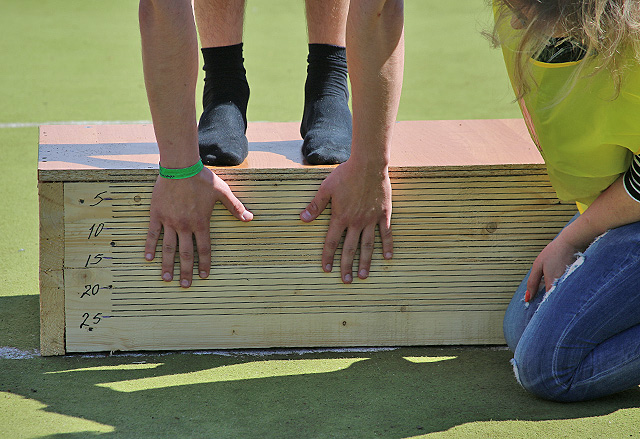This is a simplified version of the traditional sit and reach test, with the subject standing rather than sitting. The subject stands on a raised surface and bend forwards with straight legs. Measure how far past the toes the fingers can reach.
purpose: to measure the flexibility of the lower back and hamstring muscles (the back of the legs).
equipment required: step or table, ruler.
pre-test: Explain the test procedures to the subject. Perform screening of health risks and obtain informed consent. Prepare forms and record basic information such as age, height, body weight, gender, test conditions. Perform an appropriate warm-up. See more details of pre-test procedures.
 stand and reach testing
stand and reach testingprocedure: The subject stands erect, bare-footed, and with feet slightly apart and legs held straight, on the edge of a step or other raised platform. The subject then bends at the waist, leaning slowly forwards stretching the arms out towards the toes, the hands held flat with the fingers outstretched. Bouncing and jerking are not allowed. Hold the position for two seconds. Lean a ruler against the step, and measure the level of the finger-tips.
scoring: The score is recorded to the nearest centimeter or half inch as the distance reached. If the subject can reach past their toes, measure the distance how far past the toes they can reach. Any distance before the toes will be a negative score.
variations: The Toe Touch test is very similar to this test, measuring how close the fingers can reach the toes. In the Kraus-Weber Floor Touch Test, the fingers are held touching the floor for 10 seconds.
reliability: The reliability of this test will depend on the amount of warm-up allowed, and whether the same procedures are followed each time.
Similar Tests
- Kraus-Weber Floor Touch Test — can the subject touch their toes for 10 seconds?
- Toe Touch — a simple test which measures the distance from your fingertips to ground.
- Schober test — measures the flexibility of the lumbar spine based on the stretching of the skin over the lumbar spine while bending forwards.
- Sit and reach test — there are many versions.
Related Pages
- Sit and Reach Test Results.
- Make your own Sit and Reach testing box.
- Sit and Reach Test Videos and other Flexibility Test Videos
- The general Sit and Reach test procedure, including links to other versions of the sit and reach test.
- Other flexibility tests.
- Hamstring flexibility exercises on this list of stretches.
- This test is NOT similar to the Standing Reach Test, which measures how high you can reach up.
- Flexibility Store — items to measure flexibility.


 Current Events
Current Events